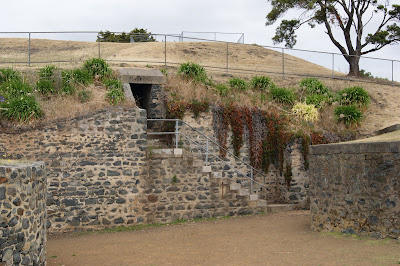He devised an ambitious plan to fortify the whole inner harbour of the Derwent River with a network of heavily armed and fortified batteries located at Macquarie Point, Battery Point and Bellerive Bluff on the eastern shore. He envisaged the forts all having an interlocking firing arc, which would cover the entire approach to Sullivans Cove, making it impossible for ships to enter the docks or attack the town unchallenged.
The scale of the plan was enormous for such a small colony, the population being approximately 20,000 in the 1830s. The small population meant the cost was too prohibitive, considering that at that period the British Empire enjoyed relative peace with the exception of border conflicts in India.
By 1855, the colony of Van Diemens Land was granted responsible self-government by the colonial Office, and renamed Tasmania. The Colonial Office began to pressure the newly formed local government to take more responsibility for the self-defence of the colony.
As a result of these calls, the Tasmanian colonial government began to establish Volunteer Local Militia Forces. One such force, established in 1859 was the Hobart Town Artillery Company under the command of Captain A. F. Smith, formerly of the 99th. (Wiltshire) Regiment, who began to assume responsibility for the Hobart fortifications from the Royal Artillery who were increasingly being withdrawn, and had all departed well before the withdrawal of the last British forces from Tasmania in 1870. Prior to this, in 1868 a Defence Proposals paper had been published which outlined the need for greater defensive fortifications. It also suggested the need for proposed batteries further to the south of Hobart Town on either side of the river.
Improvements to ship’s armaments meant that the existing fortifications, which provided covering fire to a range of approximately 2,000 yards (2,000 m), would allow enemy ships to ship outside the range of the defenders guns and still be able to bombard the town. This left the colony virtually defenceless.
The arrival of three Imperial Russian Navy warships, the Africa, Plastun, and Vestnik in 1872 caused a great deal of alarm in the colony. Britain and its empire had only been fighting the Crimean war with the Russians 16 years previously. The colony was virtually defenceless, and had the Russians had hostile intent, would probably have easily fallen. Luckily the Russians were on a good will mission, however, it cause a great deal of debate about the state of the colonies defences.
It had also highlighted the state of decay the existing fortresses had reached. Another Commission was carried out, and it was decided the Mulgrave, Prince of Wales and Prince Albert Batteries were inadequate for the defence of the town. By 1878, both had been condemned, and were dismantled by 1880. In 1882, the sites were handed over to Hobart City Council for use as public space, although the tunnels and subterranean magazines remain. Most of the stonework was removed and reused in the construction of the Alexandra Battery further to the south.
Following the condemnation of the Mulgrave, Prince of Wales, and Prince Albert batteries in 1878, it was decided to re-institute the plans for the alteration of the defensive strategy around the entrance to Sullivans Cove that were first drawn up in 1868.
A triangle of fortresses with the Queens Battery at the Apex, and two new Batteries, the Alexandra Battery, named for Princess Alexandra, the Princess of Wales, and the Kangaroo Battery on the eastern shore would be adequate for the task. Construction began on the new fortifications in 1880, and at the same time, a new permanent field artillery unit, the Southern Tasmanian Volunteer Artillery equipped with two breech-loading 12 pound howitzers and two 32 pounder guns on field carriages, was raised.
Following the dismantling of the Battery Point batteries, much of the stonework was relocated to the site of the Alexandra Battery. The site of the Alexandra Battery is now a public park with commanding views of the river, and much of the original construction is still accessible.
Alexandra Battery & Kangaroo Bluff Fort, on the opposite side of the Derwent River, are excellently preserved examples of colonial era defences and walking through and exploring each site gives you a real feel for what it must have been like to be posted to serve at one of the two fort sites. A must see, along with the Kangaroo Bluff fort site for any colonial history enthusiast.











